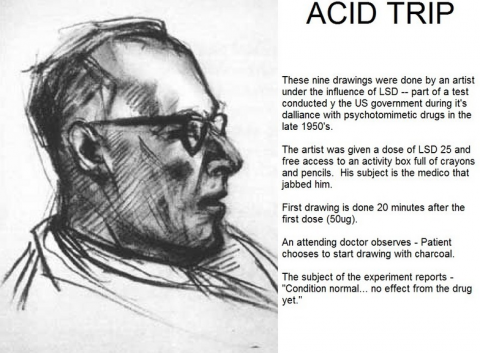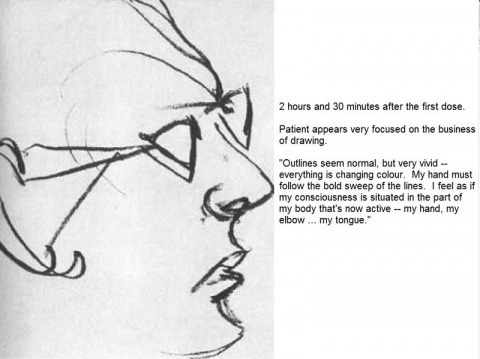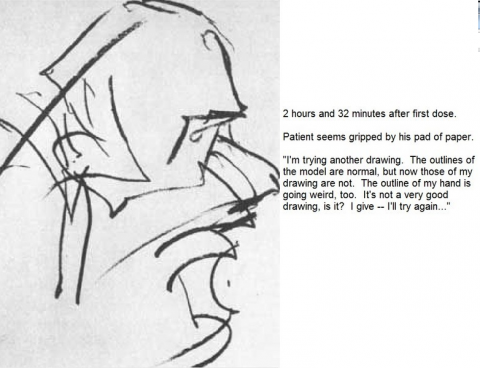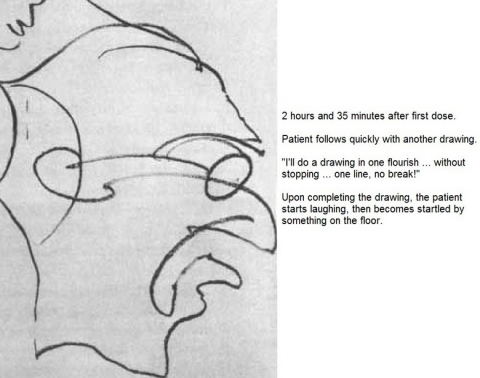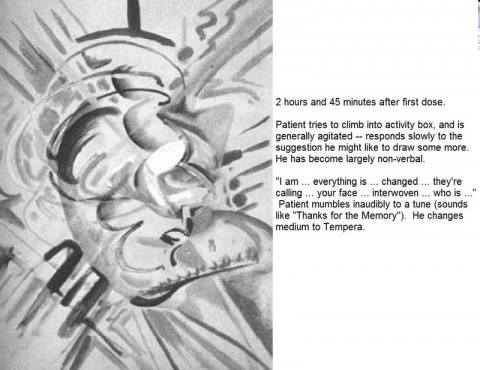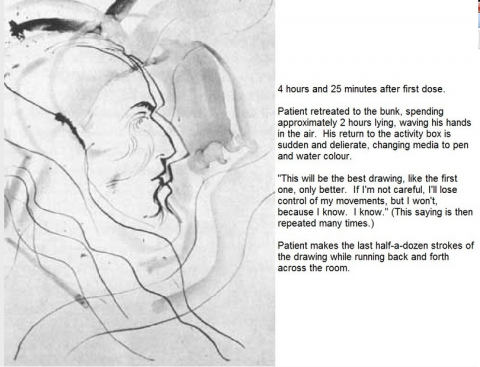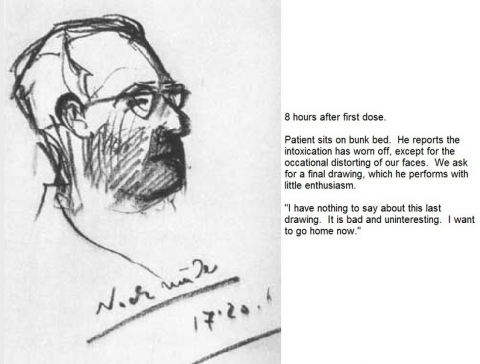Artist Draws 9 Portraits on LSD During 1950s Research Experiment
During the 1950s, a researcher gave an artist two 50-microgram doses of LSD (each dose separated by about an hour), and then the artist was encouraged to draw pictures of the doctor who administered the drugs. Nine portraits were drawn over the space of eight hours. We still don’t know the identity of the artist. But it’s surmised that the researcher was Oscar Janiger, a University of California-Irvine psychiatrist known for his work on LSD.
The web site Live Science has Andrew Sewell, a Yale Psychiatry professor (until his recent death), on record saying: “I believe the pictures are from an experiment conducted by the psychiatrist Oscar Janiger starting in 1954 and continuing for seven years, during which time he gave LSD to over 100 professional artists and measured its effects on their artistic output and creative ability. Over 250 drawings and paintings were produced.” The goal, of course, was to investigate what happens to subjects under the influence of psychedelic drugs. During the experiment, the artist explained how he felt as he worked on each sketch. You can watch how things unfolded below (or above):
20 Minutes After First Dose. Artist Claims to Feel Normal
85 Minutes After First Dose: Artist Says “I can see you clearly. I’m having a little trouble controlling this pencil.”
2 hours 30 minutes after first dose. “I feel as if my consciousness is situated in the part of my body that’s now active — my hand, my elbow… my tongue.”
2 hours 32 minutes: ‘I’m trying another drawing… The outline of my hand is going weird too. It’s not a very good drawing is it?”
2 hours 35 minutes: Patient follows quickly with another drawing. ‘I’ll do a drawing in one flourish… without stopping… one line, no break!”
2 hours 45 minutes: Agitated patient says “I am… everything is… changed… they’re calling… your face… interwoven… who is…” He changes medium to Tempera.
4 hours 25 minutes: After taking a break, the patient changes to pen and water color. “This will be the best drawing, like the first one, only better.”
5 hours 45 minutes. “I think it’s starting to wear off. This pencil is mighty hard to hold.” (He is holding a crayon).
8 hours later: The intoxication has worn off. Patient offers up a final drawing.
Related Content:
R. Crumb Describes How He Dropped LSD in the 60s & Instantly Discovered His Artistic Style
Algerian Cave Paintings Suggest Humans Did Magic Mushrooms 9,000 Years Ago
Read More...Who’s Behind These Scammy Text Messages We’ve All Been Getting?: The Search Engine Podcast Demystifies the Global Scam
You have received those odd text messages from a stranger. (“Hi, This is Anita. Have you received the Panamera parts yet?”) You know the messages are spam, but you don’t quite understand the angle of the scam. Above, the Search Engine podcast works with Bloomberg reporter Zeke Faux to break down the con operation. The story turns out to be more complicated than it first appears. It involves crypto, but also human trafficking and forced labor compounds in Cambodia and Myanmar. We’ll just leave it at that and suggest you listen to this unnerving podcast episode. You can hopefully stream it above or find it on your favorite podcast platform—e.g., Apple and Spotify.
Read More...How Walking Fosters Creativity: Stanford Researchers Confirm What Philosophers & Writers Have Always Known

Image via Diego Sevilla Ruiz
A certain Zen proverb goes something like this: “A five year old can understand it, but an 80 year old cannot do it.” The subject of this riddle-like saying has been described as “mindfulness”—or being absorbed in the moment, free from routine mental habits. In many Eastern meditative traditions, one can achieve such a state by walking just as well as by sitting still—and many a poet and teacher has preferred the ambulatory method.
This is equally so in the West, where we have an entire school of ancient philosophy—the “peripatetic”—that derives from Aristotle and his contemporaries’ penchant for doing their best work while in leisurely motion. Friedrich Nietzsche, an almost fanatical walker, once wrote, “all truly great thoughts are conceived by walking.” Nietzsche’s mountain walks were athletic, but walking—Frédéric Gros maintains in his A Philosophy of Walking—is not a sport; it is “the best way to go more slowly than any other method that has ever been found.”
Gros discusses the centrality of walking in the lives of Nietzsche, Rimbaud, Kant, Rousseau, and Thoreau. Likewise, Rebecca Solnit has profiled the essential walks of literary figures such as William Wordsworth, Jane Austen, and Gary Snyder in her book Wanderlust, which argues for the necessity of walking in our own age, when doing so is almost entirely unnecessary most of the time. As great walkers of the past and present have made abundantly clear—anecdotally at least—we see a significant link between walking and creative thinking.
More generally, writes Ferris Jabr in The New Yorker, “the way we move our bodies further changes the nature of our thoughts, and vice versa.” Applying modern research methods to ancient wisdom has allowed psychologists to quantify the ways in which this happens, and to begin to explain why. Jabr summarizes the experiments of two Stanford walking researchers, Marily Oppezzo and her mentor Daniel Schwartz, who found that almost two hundred students tested showed markedly heightened creative abilities while walking. Walking, Jabr writes in poetic terms, works by “setting the mind adrift on a frothing sea of thought.”
Oppezzo and Schwartz speculate, “future studies would likely determine a complex pathway that extends from the physical act of walking to physiological changes to the cognitive control of imagination.” They recognize that this discovery must also account for such variables as when one walks, and—as so many notable walkers have stressed—where. Researchers at the University of Michigan have tackled the where question in a paper titled “The Cognitive Benefits of Interacting with Nature.” Their study, writes Jabr, showed that “students who ambled through an arboretum improved their performance on a memory test more than students who walked along city streets.”
One wonders what James Joyce—whose Ulysses is built almost entirely on a scaffolding of walks around Dublin—would make of this. Or Walter Benjamin, whose concept of the flâneur, an archetypal urban wanderer, derives directly from the insights of that most imaginative decadent poet, Charles Baudelaire. Classical walkers, Romantic walkers, Modernist walkers—all recognized the creative importance of this simple movement in time and space, one we work so hard to master in our first years, and sometimes lose in later life if we acquire it. Going for a walk, contemporary research confirms—a mundane activity far too easily taken for granted—may be one of the most salutary means of achieving states of enlightenment, literary, philosophical, or otherwise, whether we roam through ancient forests, over the Alps, or to the corner store.
Note: An earlier version of this post appeared on our site in 2015.
via The New Yorker/Stanford News
Related Content:
Why You Do Your Best Thinking In The Shower: Creativity & the “Incubation Period”
Josh Jones is a writer and musician based in Durham, NC. Follow him at @jdmagness
Read More...Marie Curie’s Research Papers Are Still Radioactive a Century Later

Image by The Wellcome Trust
When researching a famous historical figure, access to their work and materials usually proves to be one of the biggest obstacles. But things are much more difficult for those writing about the life of Marie Curie, the scientist who, along her with husband Pierre, discovered polonium and radium and birthed the idea of particle physics. Her notebooks, her clothing, her furniture (not to mention her lab), pretty much everything surviving from her Parisian suburban house, is radioactive, and will be for 1,500 years or more.
If you want to look at her manuscripts, you have to sign a liability waiver at France’s Bibliotheque Nationale, and then you can access the notes sealed in a lead-lined box. The Curies didn’t know about the dangers of radioactive materials, though they did know about radioactivity. Their research attempted to find out which substances were radioactive and why, and so many dangerous elements–thorium, uranium, plutonium–were just sitting there in their home laboratory, glowing at night, which Curie thought beautiful, “like faint, fairy lights,” she wrote in her autobiography. Marie Curie carried these glowing objects around in her pockets. She and her husband wore standard lab clothing, nothing more.
Marie Curie died at age 66 in 1934, from aplastic anemia, attributed to her radioactive research. The house, however, continued to be used up until 1978 by the Institute of Nuclear Physics of the Paris Faculty of Science and the Curie Foundation. After that it was kept under surveillance, authorities finally now aware of the dangers inside. When many people in the neighborhood noticed high cancer rates among them, as reported in Le Parisien, they blamed the Curie’s home.
The laboratory and the building were decontaminated in 1991, a year after the Curie estate began allowing access to Curie’s notes and materials, which had been removed from the house. A flood of biographies appeared soon after: Marie Curie: A Life by Susan Quinn in 1995, Pierre Curie by Anna Hurwic in 1998, Curie: Le rêve scientifique by Loïc Barbo in 1999, Marie Curie et son laboratoire by Soraya Boudia in 2001, Obsessive Genius: The Inner World of Marie Curie by Barbara Goldsmith in 2005, and Radioactive: Marie and Pierre Curie, a Tale of Love and Fallout by Lauren Redniss in 2011.
Still, passing away at 66 is not too shabby when one has changed the world in the name of science. Marie Curie was the first woman to win a Nobel Prize (1903), the only woman to win it again (1911), the first woman to become a professor at the University of Paris, and the first woman to be entombed (on her own merits) at the Panthéon in Paris. And she managed many of her breakthroughs after the passing of her husband Pierre in 1906–who slipped and fell in the rain on a busy Paris street and was run over by the wheels of a horse-drawn cart.
Note: An earlier version of this post appeared on our site in 2015.
Related Content:
An Animated Introduction to the Life & Work of Marie Curie, the First Female Nobel Laureate
An Animated Introduction to the Life & Work of Marie Curie, the First Female Nobel Laureate
Ted Mills is a freelance writer on the arts who currently hosts the FunkZone Podcast. You can also follow him on Twitter at @tedmills, read his other arts writing at tedmills.com and/or watch his films here.
Read More...A Researcher Identifies the Old Man on the Iconic Cover of Led Zeppelin IV, 52 Years After the Album’s Release

Who’s that bearded man on the cover of Led Zeppelin IV, the one hunched over, carrying a large bundle of sticks? Brian Edwards, a researcher from the University of the West of England, has solved the 52-year-old mystery. Looking through a photo album while conducting research, Edwards spotted a photograph and, being a Led Zeppelin fan, “instantly recognised the man with the sticks.” “It was quite a revelation, he told the BBC.” From there, he figured out who took the photograph in 1892 (Ernest Howard Farmer), and eventually identified the figure in the photo itself: Lot Long, a thatcher from Mere, a town in Wiltshire, England. You can see him above.
Decades later, Robert Plant apparently found a colorized version of the photograph in an antique shop. On the 1971 album cover, we see the photo turned into a framed painting and layered onto the wall of a drab home. The rest, as they say, is rock ’n’ roll history…
Related Content
William S. Burroughs Reviews a Led Zeppelin Concert for Crawdaddy! Magazine (1975)
Hear Led Zeppelin’s First Recorded Concert Ever (1968)
Read More...Researchers Use AI to Decode the First Word on an Ancient Scroll Burned by Vesuvius

In the year 79, AD Mount Vesuvius erupted, burying both Pompeii and Herculaneum. In 1750, an Italian farmworker discovered an entombed seaside villa in Herculaneum while digging a well. When excavated, the residence yielded hundreds of scrolls, all of them turned into what looked and felt like lumps of ash, and practically all of them unrollable, let alone readable. Only in 2015 did humankind — or more specifically, University of Kentucky computer scientist Brent Seales and his team — develop the technology that could let us see what texts these ancient scrolls contain. Eventually, a particle accelerator and machine learning came into play. This timeline comes from the web site of the Vesuvius Challenge, “a machine learning and computer vision competition to read the Herculaneum Papyri.”
Funded by technology entrepreneurs Nat Friedman and Daniel Gross, the Vesuvius Challenge has given out $260,000 of its $1 million of prizes so far, including $40,000 to undergraduate student/engineer Luke Farritor, who identified ten letters in a section of one scroll, and $10,000 to biorobotics graduate student Youssef Nader, who subsequently and independently discovered those same letters.
The word they form? Porphyras, ancient Greek for “purple”: a color, incidentally, that signified wealth and power in the ancient world, not least because of the enormous amount of labor required to extract it from nature. That the Herculaneum Papyri have started to become readable also represents the culmination of a similarly impressive effort, albeit one based on technological development rather than the extraction of sea-snail glands.
As Nicholas Wade writes in the New York Times, the current method “uses computer tomography, the same technique as in CT scans” — executed with the aforementioned particle accelerator — “plus advancements in artificial intelligence” used “to help distinguish ink from papyrus.” You can learn more about the Vesuvius Challenge in the video above. Its creator Garrett Ryan, of ancient-history Youtube channel Told in Stone, has been previously featured here on Open Culture for his explanation of how 99 percent of ancient texts were lost — which means these charred scrolls could hold a great deal of knowledge about the ancient world. Do they contain, as Ryan fantasizes, the lost books of Livy, the dialogues of Aristotle, poems by Sappho? We’ll only know when someone figures out how best to use technology to decode them all. Artificial intelligence may be the key to the future, as we’ve often heard in recent years, but in this particular case, it offers a promising key to the past.
Related content:
Pompeii Rebuilt: A Tour of the Ancient City Before It Was Entombed by Mount Vesuvius
How 99% of Ancient Literature Was Lost
A Newly-Discovered Fresco in Pompeii Reveals a Precursor to Pizza
Based in Seoul, Colin Marshall writes and broadcasts on cities, language, and culture. His projects include the Substack newsletter Books on Cities, the book The Stateless City: a Walk through 21st-Century Los Angeles and the video series The City in Cinema. Follow him on Twitter at @colinmarshall or on Facebook.
Read More...How to Be Happier in 5 Research-Proven Steps, According to Popular Yale Professor Laurie Santos
Nature doesn’t care if you’re happy, but Yale psychology professor Laurie Santos does.
As Dr. Santos points out during the above appearance on The Well, the goals of natural selection have been achieved as long as humans survive and reproduce, but most of us crave something more to consider life worth living.
With depression rising to near epidemic levels on college campuses and elsewhere, it’s worth taking a look at our ingrained behavior, and maybe making some modifications to boost our happiness levels.
Psychology and the Good Life, Dr. Santos’ massive twice weekly lecture class that actively tackles ways of edging closer to happiness, is the most popular course in Yale’s more than 300-year history.
Do we detect some resistance?
Positive psychology — or the science of happiness — is a pretty crowded field lately, and the overwhelming demand created by great throngs of people longing to feel better has attracted a fair number of grifters willing to impart their proven methodologies to anyone enrolling in their paid online courses.
By contrast, Dr. Santos not only has that Yale pedigree, she also cites other respected academics such as the University of Chicago’s Nicholas Epley, a social cognition specialist who believes undersociality, or a lack of face-to-face engagement, is making people miserable, and Harvard’s Dan Gilbert and the University of Virginia’s Timothy Wilson, who co-authored a paper on “miswanting”, or the tendency to inaccurately predict what will truly result in satisfaction and happiness.
Yale undergrad Mickey Rose, who took Psychology and the Good Life in the spring of 2022 to fulfill a social science credit, told the Yale Daily News that her favorite part of the class was that “everything was cited, everything had a credible source and study to back it up:”
I’m a STEM major and it’s kind of my overall personality type to question claims that I find not very believable. Obviously the class made a lot of claims about money, grades, happiness, that are counterintuitive to most people and to Yale students especially.
With Psychology and the Good Life now available to the public for free on Coursera, even skeptics might consider giving Dr. Santos’ recommended “re-wirement practices” a peek, though be forewarned, you should be prepared to put them into practice before making pronouncements as to their efficacy.
It’s all pretty straightforward stuff, starting with “use your phone to actually be a phone”, meaning call a friend or family member to set up an in person get together rather than scrolling through endless social media feeds.
Other common sense adjustments include looking beyond yourself to help by volunteering, resolving to adopt a glass-is-half-full type attitude, cultivating mindfulness, making daily entries in a gratitude journal, and becoming less sedentary.
(You might also give Dr. Santos’ Happiness Lab podcast a go…)
Things to guard against are measuring your own happiness against the perceived happiness of others and “impact bias” — overestimating the duration and intensity of happiness that is the expected result of some hotly anticipated event, acquisition or change in social standing.
Below Dr. Santos gives a tour of the Good Life Center, an on-campus space that stressed out, socially anxious students can visit to get help putting some of those re-wirement practices into play.
Sign up for Coursera’s 10-week Science of Well-Being course here.
Related Content
The Science of Well-Being: Take a Free Online Version of Yale University’s Most Popular Course
Free Online Psychology & Neuroscience Courses, a subset of our collection, 1,700 Free Online Courses from Top Universities
What Are the Keys to Happiness? Lessons from a 75-Year-Long Harvard Study
– Ayun Halliday is the Chief Primatologist of the East Village Inky zine and author, most recently, of Creative, Not Famous: The Small Potato Manifesto and Creative, Not Famous Activity Book. Follow her @AyunHalliday.
Read More...Everything You Wanted to Ask About Psychedelics: A Johns Hopkins Psychedelics Researcher Answers 24 Questions in 2 Hours
?si=Kq5T7I10zGKJa-bE
These days, psychedelic research is experiencing a renaissance of sorts. And Matt Johnson, a professor of psychiatry at Johns Hopkins, is leading the way. One of “the world’s most published scientists on the human effects of psychedelics,” his research focuses on “unraveling the scientific underpinnings of psychedelic substances, moving beyond their historical and cultural context to shed light on their role in modern therapeutic applications.” Like some other researchers before him, he believes that psychedelics ultimately have the “potential to bring about a paradigm shift in psychiatry, neuroscience, and pharmacology.” In the Big Think video above, the professor answers 24 big questions about psychedelics, from “What are the main effects of psychedelics?,” to “How do psychedelics work in the brain?” and “What are the biggest risks of psychedelics?,” to “Will psychedelics answer the hard problem of consciousness?” Johnson covers a lot of ground here. Settle in. The video runs 2+ hours.
Related Content
Michael Pollan, Sam Harris & Others Explain How Psychedelics Can Change Your Mind
Inside MK-Ultra, the CIA’s Secret Program That Used LSD to Achieve Mind Control (1953–1973)
Read More...Is Coffee Good for You?: A Coffee Connoisseur Reviews the Scientific Research
According to NPR, “Caffeine is the most widely consumed drug in the world. Here in the U.S., according to a 2022 survey, more than 93% of adults consume caffeine, and of those, 75% consume caffeine at least once a day.” Given the prevalence of coffee worldwide, it pays to ask a simple question: Is coffee good for you? Above, James Hoffmann, the author of The World Atlas of Coffee, provides an overview of research examining the relationship between coffee and various dimensions of health, including the gut/microbiome, sleep, cancer, cognition, mortality and more. If you want to explore this subject more deeply, Hoffmann has created a list of the research papers reviewed here.
If you would like to sign up for Open Culture’s free email newsletter, please find it here. Or follow our posts on Threads, Facebook, BlueSky or Mastodon.
If you would like to support the mission of Open Culture, consider making a donation to our site. It’s hard to rely 100% on ads, and your contributions will help us continue providing the best free cultural and educational materials to learners everywhere. You can contribute through PayPal, Patreon, and Venmo (@openculture). Thanks!
Related Content
Philosophers Drinking Coffee: The Excessive Habits of Kant, Voltaire & Kierkegaard
How Coffee Affects Your Brain: A Very Quick Primer
Why Coffee Naps Will Perk You Up More Than Either Coffee, or Naps, Alone
Paul Giamatti Plays Honoré de Balzac, Hopped Up on 50 Coffees Per Day
Read More...In Search of the Best Croissant in Protest-Filled Paris
An Italian tourist went to Paris in search of the best croissant. A natural thing to do. Except he did it amidst a city-wide strike, one precipitated by Emmanuel Macron’s attempt to raise the minimum retirement age in France. It all makes for a unique kind of food/travel video.
So what boulangeries (bakeries) made the list? Tout Autour du Pain on rue de Turenne; Carton Paris on Boulevard de Denain; Stohrer (established in 1730) on Rue Montorgueil; Du Pain et des Idées on Rue Yves Toudic; and Cedric Grolet OPÉRA on rue de l’Opéra.
And what bakery takes the proverbial cake? Turns out, it’s Du Pain et des Idées. When we visit Paris in June, we’ll be sure to stop by…
If you would like to sign up for Open Culture’s free email newsletter, please find it here. Or follow our posts on Threads, Facebook, BlueSky or Mastodon.
If you would like to support the mission of Open Culture, consider making a donation to our site. It’s hard to rely 100% on ads, and your contributions will help us continue providing the best free cultural and educational materials to learners everywhere. You can contribute through PayPal, Patreon, and Venmo (@openculture). Thanks!
via Kottke
Related Content
French Café Adds Extra Charge for Rude Customers
See Ridley Scott’s 1973 Bread Commercial—Voted England’s Favorite Advertisement of All Time
Science & Cooking: Harvard’s Free Course on Making Cakes, Paella & Other Delicious Food
Read More...